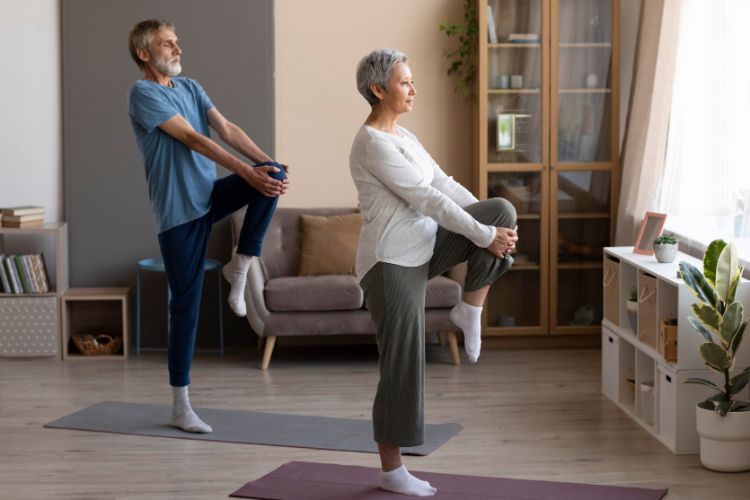Maintaining an active lifestyle becomes increasingly crucial for our overall health and well-being. Exercise not only helps seniors stay physically fit but also improves mood, cognitive function, and quality of life. In this comprehensive guide, we’ll explore a range of exercises specifically designed for seniors, focusing on enhancing strength, flexibility, balance, and cardiovascular health.
Importance of exercise for seniors
Engaging in regular physical activity is essential for seniors to maintain independence, reduce the risk of chronic diseases, and enhance overall quality of life. Exercise promotes healthy aging by improving muscle strength, flexibility, and cardiovascular health, which are vital for performing daily tasks and preventing falls and injuries.
Regular physical activity also has numerous mental health benefits for seniors, including reducing the risk of depression, anxiety, and cognitive decline. By staying active, seniors can boost their mood, enhance cognitive function, and maintain a positive outlook on life.
Types of Exercises for Seniors
Let’s explore different types of exercises which are tailored specifically for seniors.
Cardiovascular Exercises
Cardiovascular exercises, also known as aerobic exercises, are crucial for seniors as they help improve heart health, increase stamina, and boost mood. Examples of cardiovascular exercises suitable for seniors include walking, swimming, cycling, and dancing.
Strength Training
Strength training exercises are essential for maintaining muscle mass and bone density, both of which tend to decline with age. Simple bodyweight exercises like squats, lunges, and push-ups, as well as resistance band exercises, can help seniors build strength and improve overall function.
Flexibility Exercises
Flexibility exercises focus on improving joint mobility and range of motion. Stretching exercises such as yoga and Pilates help seniors maintain flexibility, reduce stiffness, and alleviate joint pain.
Balance Exercises
Balance exercises are particularly important for seniors as they help prevent falls, which can have serious consequences. Activities like Tai Chi, Qigong, and specific balance exercises can improve stability and coordination, reducing the risk of accidents.
Best Exercises for Seniors
When it comes to exercise for seniors, it’s essential to focus on activities that are safe, low-impact, and enjoyable. Here are some recommended exercises for seniors of all fitness levels:
Walking: Step Into Better Health
Walking is one of the simplest yet most effective forms of exercise for seniors. It’s low-impact, easy on the joints, and can be done almost anywhere. Aim for at least 30 minutes of brisk walking each day to reap the benefits of improved cardiovascular health, increased stamina, and enhanced mood.
Chair Yoga: Find Your Inner Balance
Chair yoga offers seniors a gentle way to improve flexibility, strength, and mindfulness. With a focus on seated poses and modified movements, it’s accessible for individuals with limited mobility or balance issues. Incorporating chair yoga into your routine can help alleviate stiffness, reduce stress, and promote relaxation.
Resistance Training: Build Stronger Muscles
Strength training exercises, such as lifting weights or using resistance bands, are crucial for maintaining muscle mass and bone density as we age. Start with light weights and gradually increase resistance as you build strength. Target major muscle groups with exercises like bicep curls, leg presses, and chest presses to enhance overall physical function and prevent age-related muscle loss.
Water Aerobics: Dive into Fitness
Water aerobics provides a low impact yet highly effective workout for seniors, offering buoyancy and resistance to strengthen muscles and improve cardiovascular health. Whether in a pool or shallow water, exercises like water walking, leg lifts, and arm circles can help increase flexibility, endurance, and range of motion while minimizing stress on the joints.
Tai Chi: Flow into Serenity
Tai Chi is a graceful form of martial arts that focuses on slow, controlled movements and deep breathing. Suitable for all fitness levels, it promotes relaxation, balance, and mental clarity. Practicing Tai Chi regularly can help seniors reduce falls, alleviate arthritis pain, and enhance overall well-being by fostering a sense of harmony between body and mind.
Cycling: Pedal Your Way to Fitness
Cycling, whether outdoors or on a stationary bike, offers seniors a fun and effective way to improve cardiovascular health and leg strength. Start with short, leisurely rides and gradually increase duration and intensity as your fitness improves. Cycling not only boosts physical fitness but also provides opportunities for exploration and social interaction.
Benefits of Exercise for Seniors
Regular physical activity offers a myriad of benefits for seniors, including:
Enhanced Mobility and Flexibility
Engaging in exercises that focus on flexibility and mobility can help seniors maintain joint health and range of motion, making daily activities easier and reducing the risk of falls.
Improved Cardiovascular Health
Cardiovascular exercises, such as walking, swimming, or cycling, strengthen the heart and lungs, improving circulation and lowering the risk of heart disease and stroke.
Strength and Balance
Strength training exercises help seniors build muscle mass and improve balance, reducing the risk of falls and fractures.
Mental Well-being
Exercise releases endorphins, the body’s natural mood lifters, promoting feelings of happiness and reducing stress and anxiety.
Social Engagement
Participating in group exercise classes or outdoor activities provides opportunities for social interaction, reducing feelings of loneliness and isolation.
Tips for Getting Started
Before starting any new exercise program, it’s essential to consult with your healthcare provider, especially if you have any underlying health conditions or concerns. Once you have the green light, follow these tips to get started safely:
- Start Slowly: Begin with short sessions of light exercise and gradually increase the duration and intensity as your fitness improves.
- Listen to Your Body: Pay attention to how your body feels during and after exercise. If you experience pain or discomfort, stop and rest.
- Stay Hydrated: Drink plenty of water before, during, and after exercise to prevent dehydration, especially in hot weather.
- Use Proper Equipment: Wear supportive shoes and comfortable clothing suitable for your chosen activity. If using equipment, make sure it’s in good condition and appropriate for your needs.
Conclusion
Incorporating regular exercise into your routine is essential for maintaining optimal health and well-being as you age. By engaging in a variety of exercises that focus on strength, flexibility, balance, and cardiovascular health, seniors can enhance their physical fitness, improve mobility, and enjoy a higher quality of life.
Remember to consult with your healthcare provider before starting any new exercise program, especially if you have pre-existing health conditions or concerns. Stay active, stay healthy, and enjoy the benefits of exercises for seniors!
Frequently Asked Questions (FAQs)
Are these exercises safe for seniors with chronic health conditions?
While exercise is generally safe for most seniors, those with chronic health conditions should consult with their healthcare provider before starting any new exercise program to ensure it’s safe and appropriate for their individual needs.
How often should seniors exercise?
Seniors should aim for at least 150 minutes of moderate-intensity aerobic activity per week, spread out over several days. Additionally, incorporating strength training exercises two to three times per week is recommended for optimal health benefits.
Can seniors start exercising if they’ve been inactive for a long time?
Absolutely! It’s never too late to start exercising. Seniors should begin slowly and gradually increase the intensity and duration of their workouts as they build strength and endurance.
What if seniors experience pain during exercise?
Seniors should never push through pain during exercise. If they experience any discomfort, they should stop immediately and consult with their healthcare provider to determine the cause and appropriate course of action.
Are there any specific exercises to improve posture for seniors?
Yes, exercises such as shoulder blade squeezes, chest stretches, and seated spinal twists can help improve posture and alleviate discomfort associated with poor posture.
Is it necessary for seniors to warm up before exercising?
Yes, warming up before exercise is essential for seniors to prepare their muscles and joints for physical activity, reducing the risk of injury. A brief warm-up consisting of light aerobic activity and dynamic stretches is recommended.




